- Docente: Davide Fabiani
- Credits: 6
- SSD: ING-IND/33
- Language: Italian
- Teaching Mode: In-person learning (entirely or partially)
- Campus: Bologna
- Corso: Second cycle degree programme (LM) in Electrical Energy Engineering (cod. 9066)
Learning outcomes
The course aims to deepen the knowledge of basic and innovative technologies in the field of electricity production, storage and transport, with particular emphasis on photovoltaics, fuel cells, batteries and superconductors. At the end of the course the student, besides the knowledge of the aforementioned technologies, is able to design simple photovoltaic systems, energy storage and high-temperature superconducting cables.
Course contents
I Applications of Nanotechnologies in electric and energy engineering
1 . Nanostructured materials: main methods of synthesis, characterization of the properties, polymer / lamellar silicates, carbon nanotubes
2 . Outline of the main applications of nanostructured materials in the field of energy: batteries, fuel cells, photovoltaic panels.
II Photovoltaic energy production
1 . Photovoltaic effect. Main technologies in the field of photovoltaics: silicon cells (monocrystalline, polycrystalline, amorphous) thin film solar cells, organic cells.
2 . Design criteria of stand-alone and grid-connected photovoltaic system and connection to the grid. Examples of design by using a commercial software.
III Electrochemical energy storage
1 . Principles of operation of batteries: pile of Volta and Daniell, polarization and reversibility
2 . Battery specifications: voltage, capacity and their dependence on design factors.
3 . Primay and Secondary Batteries : acid accumulators (fundamental electrochemical reactions, gassing and gas recombination, characteristics of lead-acid cells ); alkaline batteries (type, electrochemical reactions, fundamental characteristics of Ni-Cd cells, sealed batteries), secundary batteries for automotive.
4 . Innovative batteries: zinc / air cells, Zebra, lithium- ion and lithium polymer.
IV Fuel Cells
1 . Principles of operation of the cell, the effect of operating parameters on performance.
2 . Types of cells ( AFC, PEMFC, DMFC, PAFC , MCFC and SOFC) and applications.
3 . Main methods of hydrogen production (electrolysis and reforming).
V Superconductor components
1 . General aspects of superconductivity: history, macroscopic properties, phenomenology of superconductors, superconducting type I, critical temperature, critical field, critical current, critical frequency and correlations, intermediate state and mixed state, type II superconductors, London theory , Ginnzburg -Landau and BCS theories, superconductors and real phenomena (pinning).
2 . Superconducting oxides - a new class of materials for electrical engineering: superconducting materials for electrical applications, crystal structure and methods of preparation, YBCO and BSCCO, configuration of the superconducting components for energy applications.
3 . Methods for electromagnetic characterization of superconductors: measurement of critical current, measure of magnetization and hysteresis loop. Laboratory exercises.
4 . Applications in the energy sector: different types of applications (MRI, current limiters, SMES, motors and transformers, superconducting cables ).
Readings/Bibliography
E-book (free) of the course: D. Fabiani, Innovative Electrical Technologies for Electrical and Energy Engineers, 2019.
Slides projected in the classroom.
Books recommended for in-depth analysis:
- J. K. Nelson (ed.), Dielectric Polymer Nanocomposites, Springer, 2010
- R. A. Huggins, Advanced Batteries, Springer, 2008.
- V. Shmidt, P. Müller, A. V. Ustinov, The physics of superconductors: introduction to fundamentals and applications, Springer, 1997
- J. Poortmans, V. Arkhipov, Thin film solar cells: fabrication, characterization and applications, Wiley, 2007
Teaching methods
The course consists of
1) lectures in classroom;
2) training on design of a phovoltaic plant, storage system and fuel cell by using commercial softwares;
3) laboratory demonstrations on superconductors, batteries and photovoltaic cells.
Assessment methods
The exam for attending students can be divided into two partial tests on half the program: an intermediate test, approximately halfway through the course, and a final test, immediately after the end of the course. The mid-term exam is written while part of the final exam could be oral.
Both tests, lasting a maximum of two hours each, consist of 10 open-ended questions and / or exercises on the topics relating to the parts of the program covered by the test itself. Eight of these questions require short and targeted answers while the remaining two require a broader and more articulate answer, possibly even oral if required by the test.
Each test is assigned a maximum score of 32; sufficiency is achieved with a score of 18. An insufficiency or absence from the first partial test precludes the possibility of taking the second. The final mark, out of thirty, is obtained from the arithmetic average of the marks of the two tests rounded to the nearest integer. Honors can be awarded if the final score is ≥ 31. Once the final grade is known, the student must decide whether to accept or reject the grade before the deadline communicated by the teacher.
The refusal of the grade, insufficiency, or absence in one or both partial tests involves the repetition of the exam in a single session on the whole program.
All sessions following the final partial exam will take place over the entire program in a single session in the same way as the partial tests described above.
Passing the exam will be guaranteed to students who demonstrate mastery and operational skills in relation to the key concepts illustrated in the teaching, and in particular to photovoltaic, superconducting technologies and related to electrochemical storage systems.
A higher score will be awarded to students who demonstrate that they understand and are able to use all the teaching contents, illustrating them with language skills, solving even complex problems and showing good operational skills.
Failure to pass the exam may be due to insufficient knowledge of key concepts, in particular relating to traditional and innovative storage systems, superconductivity phenomena, and photovoltaic systems, as well as the lack of mastery of technical language.
If the final grade is less than 18/30 the student will be rejected and will not be able to take a new test before 15 days.
The student has the right to reject a positive grade assigned by the teacher a maximum of two times.
Teaching tools
Didactic material will be provided online by the teacher on the website platform "virtuale.unibo.it". Click on the link regarding didactic material.
Commercial software on design of PV plants and storage systems will be used for training sessions, e.g. PV-SYST or similar.
Office hours
See the website of Davide Fabiani
SDGs



This teaching activity contributes to the achievement of the Sustainable Development Goals of the UN 2030 Agenda.
